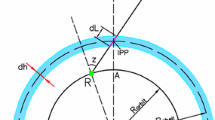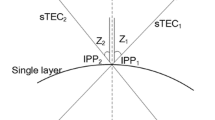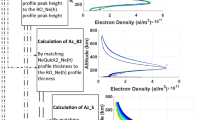Abstract
The ionosphere effective height (IEH) is a very important parameter in total electron content (TEC) measurements under the widely used single-layer model assumption. To overcome the requirement of a large amount of simultaneous vertical and slant ionospheric observations or dense “coinciding” pierce points data, a new approach comparing the converted vertical TEC (VTEC) value using mapping function based on a given IEH with the “ground truth” VTEC value provided by the combined International GNSS Service Global Ionospheric Maps is proposed for the determination of the optimal IEH. The optimal IEH in the Chinese region is determined using three different methods based on GNSS data. Based on the ionosonde data from three different locations in China, the altitude variation of the peak electron density (hmF2) is found to have clear diurnal, seasonal and latitudinal dependences, and the diurnal variation of hmF2 varies from approximately 210 to 520 km in Hainan. The determination of the optimal IEH employing the inverse method suggested by Birch et al. (Radio Sci 37, 2002. doi:10.1029/2000rs002601) did not yield a consistent altitude in the Chinese region. Tests of the method minimizing the mapping function errors suggested by Nava et al. (Adv Space Res 39:1292–1297, 2007) indicate that the optimal IEH ranges from 400 to 600 km, and the height of 450 km is the most frequent IEH at both high and low solar activities. It is also confirmed that the IEH of 450–550 km is preferred for the Chinese region instead of the commonly adopted 350–450 km using the determination method of the optimal IEH proposed in this paper.
















Similar content being viewed by others
References
Arikan F, Shukurov S, Tuna H, Arikan O, Gulyaeva T (2016) Performance of GPS slant total electron content and IRI-Plas-STEC for days with ionospheric disturbance. Geod Geodyn 7(1):1–10
Birch MJ, Hargreaves JK, Bailey GJ (2002) On the use of an effective ionospheric height in electron content measurement by GPS reception. Radio Sci 37(1): doi:10.1029/2000rs002601
Blanch J, Walter T, Enge P (2004) A new ionospheric estimation algorithm for SBAS combining kriging and tomography. In: Proceedings of the institute of navigation national technical meeting
Breed AM, Goodwin GL, Vandenberg AM, Essex EA, Lynn KJW, Silby JH (1997) Ionospheric total electron content and slab thickness determined in Australia. Radio Sci 32(4):1635–1643. doi:10.1029/97rs00454
Brunini C, Azpilicueta F (2010) GPS slant total electron content accuracy using the single layer model under different geomagnetic regions and ionospheric conditions. J Geod 84(5):293–304. doi:10.1007/s00190-010-0367-5
Brunini C, Meza A, Bosch W (2005) Temporal and spatial variability of the bias between TOPEX- and GPS-derived total electron content. J Geod 79(4–5):175–188
Brunini C, Camilion E, Azpilicueta F (2011) Simulation study of the influence of the ionospheric layer height in the thin layer ionospheric model. J Geod 85(9):637–645. doi:10.1007/s00190-011-0470-2
Brunini C, Van Zele MA, Meza A, Gende M (2003) Quiet and perturbed ionospheric representation according to the electron content from GPS signals. J Geophys Res Space 108(A2): doi:10.1029/2002ja009346
Ciraolo L, Azpilicueta F, Brunini C, Meza A, Radicella S (2007) Calibration errors on experimental slant total electron content (TEC) determined with GPS. J Geod 81(2):111–120
Conte JF, Azpilicueta F, Brunini C (2011) Accuracy assessment of the GPS-TEC calibration constants by means of a simulation technique. J Geod 85(10):707–714. doi:10.1007/s00190-011-0477-8
Davies K, Hartmann GK (1997) Studying the ionosphere with the Global Positioning System. Radio Sci 32(4):1695–1703. doi:10.1029/97rs00451
Hernández-Pajares M (2004) IGS ionosphere WG status report: performance of IGS ionosphere TEC maps-position paper. In: IGS Workshop, Bern
Hernández-Pajares M, Juan JM, Sanz J, Orus R, Garcia-Rigo A, Feltens J, Komjathy A, Schaer SC, Krankowski A (2009) The IGS VTEC maps: a reliable source of ionospheric information since 1998. J Geod 83(3–4):263–275. doi:10.1007/s00190-008-0266-1
Hernandez-Pajares M, Juan JM, Sanz J, Aragon-Angel A, Garcia-Rigo A, Salazar D, Escudero M (2011) The ionosphere: effects, GPS modeling and the benefits for space geodetic techniques. J Geod 85(12):887–907. doi:10.1007/s00190-011-0508-5
Hernández-Pajares M, Roma-Dollase D, Krankowski A, García-Rigo A, Orús-Pérez R (2017) Methodology and consistency of slant and vertical assessments for ionospheric electron content models. J Geod. doi:10.1007/s00190-017-1032-z
Huang Z, Yuan H (2013) Analysis and improvement of ionospheric thin shell model used in SBAS for China region. Adv Space Res 51(11):2035–2042. doi:10.1016/j.asr.2012.12.018
Hu L, Ning B, Liu L, Zhao B, Li G, Wu B, Huang Z, Hao X, Chang S, Wu Z (2014) Validation of COSMIC ionospheric peak parameters by the measurements of an ionosonde chain in China. Ann Geophys 32(10):1311–1319
Klobuchar JA (1987) Ionospheric time-delay algorithm for single-frequency GPS users. IEEE Trans Aerosp Electron Syst 23(3):325–331. doi:10.1109/taes.1987.310829
Komjathy A (1997) Global ionospheric total electron content mapping using the global positioning system, University of New Brunswick
Komjathy A, Langley R (1996) An assessment of predicted and measured ionospheric total electron content using a regional GPS network. In: Proceedings of the national technical meeting of the Institute of Navigation, pp. 615–624
Komjathy A, Sparks L, Mannucci A, Pi X (2003) An alternative ionospheric correction algorithm for satellite-based augmentation systems in low-latitude region. In: On the CD-ROM of the proceedings of GNSS 2003 the European navigation conference, Graz
Krankowski A, Shagimuratov II, Ephishov II, Krypiak-Gregorczyk A, Yakimova G (2009) The occurrence of the mid-latitude ionospheric trough in GPS-TEC measurements. Adv Space Res 43(11):1721–1731. doi:10.1016/j.asr.2008.05.014
Lanyi GE, Roth T (1988) A comparison of mapped and measured total ionospheric electron content using global positioning system and beacon satellite observations. Radio Sci 23(4):483–492
Li Z, Yuan Y, Wang N, Hernandez-Pajares M, Huo X (2015) SHPTS: towards a new method for generating precise global ionospheric TEC map based on spherical harmonic and generalized trigonometric series functions. J Geod 89(4):331–345
Li M, Yuan Y, Wang N, Li Z, Li Y, Huo X (2017) Estimation and analysis of Galileo differential code biases. J Geod 91:279. doi:10.1007/s00190-016-0962-1
Mannucci AJ, Wilson BD, Yuan DN, Ho CH, Lindqwister UJ, Runge TF (1998) A global mapping technique for GPS-derived ionospheric total electron content measurements. Radio Sci 33(3):565–582. doi:10.1029/97rs02707
Nava B, Radicella SM, Leitinger R, Coïsson P (2007) Use of total electron content data to analyze ionosphere electron density gradients. Adv Space Res 39(8):1292–1297. doi:10.1016/j.asr.2007.01.041
Niranjan K, Srivani B, Gopikrishna S, Rama Rao PVS (2007) Spatial distribution of ionization in the equatorial and low-latitude ionosphere of the Indian sector and its effect on the pierce point altitude for GPS applications during low solar activity periods. J Geophys Res 112(A5): doi:10.1029/2006ja011989
Okoh D, Owolabi O, Ekechukwu C, Folarin O, Arhiwo G, Agbo J, Bolaji S, Rabiu B (2016) A regional GNSS-VTEC model over Nigeria using neural networks: a novel approach. Geod Geodyn 7(1):19–31
Rao PR, Niranjan K, Prasad D, Krishna SG, Uma G (2006) On the validity of the ionospheric pierce point (IPP) altitude of 350 km in the Indian equatorial and low-latitude sector. Ann Geophys 24:2159–2168
Santos MC, van der Bree R, van der Marel H, Verhagen S, Garcia CA (2010) Experimental assessment of a PPP-based P2–C2 bias estimation. In: satellite navigation technologies and European workshop on GNSS signals and signal processing (NAVITEC), 2010 5th ESA Workshop on. IEEE, pp 1–4
Sardón E, Zarraoa N (1997) Estimation of total electron content using GPS data: how stable are the differential satellite and receiver instrumental biases? Radio Sci 32(5):1899–1910
Schaer S (1999) Mapping and predicting the Earth’s ionosphere using the Global Positioning System. Geod -Geophys Arb Schweiz 59
Schaer S, Gurtner W, Feltens J (1998) IONEX: the ionosphere map exchange format version 1. In: Proceedings of the IGS AC workshop, Darmstadt, Germany
Shi C, Gu S, Lou Y, Ge M (2012) An improved approach to model ionospheric delays for single-frequency precise point positioning. Adv Space Res 49(12):1698–1708
Wang N (2016) Study on GNSS differential code biases and global broadcast ionospheric models of GPS, Galileo and BDS. Chinese Academy of Sciences. Wuhan.
Wang N, Yuan Y, Li Z, Montenbruck O, Tan B (2016a) Determination of differential code biases with multi-GNSS observations. J Geod 90(3):209–228
Wang X-L, Wan Q-T, Ma G-Y, Li J-H, Fan J-T (2016b) The influence of ionospheric thin shell height on TEC retrieval from GPS observation. Res Astron Astrophys 16(7):016
Wang N, Yuan Y, Li Z, Li Y, Huo X, Li M (2017) An examination of the Galileo NeQuick model: comparison with GPS and JASON TEC. GPS Solut 21(2):605–615
Wilson B, Mannucci AJ (1993) Instrumental biases in ionospheric measurements derived from GPS data. In: Jet Propulsion Laboratory, California Institute of Technology, Pasadenas
Yuan YB, Ou JK (1999) The effects of instrumental bias in GPS observations on determining ionospheric delays and the methods of its calibration. Acta Geod Cartogr Sin 38:110–114
Yuan Y, Ou J (2001) An improvement to ionospheric delay correction for single-frequency GPS users-the APR-I scheme. J Geod 75(5–6):331–336
Yuan YB, Ou JK (2004) A generalized trigonometric series function model for determining ionospheric delay. Prog Nat Sci 14(11):1010–1014. doi:10.1080/10020070412331344711
Yuan YB, Huo XL, Ou JK (2007) Models and methods for precise determination of ionospheric delay using GPS. Prog Nat Sci 17(2):187–196
Yuan Y, Tscherning CC, Knudsen P, Xu G, Ou J (2008) The ionospheric eclipse factor method (IEFM) and its application to determining the ionospheric delay for GPS. J Geod 82(1):1–8. doi:10.1007/s00190-007-0152-2
Yuan Y, Li Z, Wang N, Zhang B, Li H, Li M, Huo X, Ou J (2015) Monitoring the ionosphere based on the Crustal Movement Observation Network of China. Geod Geodyn 6(2):73–80. doi:10.1016/j.geog.2015.01.004
Zhang BC, Ou JK, Yuan YB, Li ZS (2012) Extraction of line-of-sight ionospheric observables from GPS data using precise point positioning. Sci China Earth Sci 55(11):1919–1928. doi:10.1007/s11430-012-4454-8
Acknowledgements
We would like to acknowledge the use of data from the Chinese Meridian Project. We also acknowledge the IGS and Crustal Movement Observation Network of China (CMONOC) for providing access to GNSS data. This work was supported by the National Key Research Program of China “Collaborative Precision Positioning Project” (No.2016YFB0501900), China Natural Science Funds (No. 41231064, 41674022, 41604031, 41574015).
Author information
Authors and Affiliations
Corresponding authors
Rights and permissions
About this article
Cite this article
Li, M., Yuan, Y., Zhang, B. et al. Determination of the optimized single-layer ionospheric height for electron content measurements over China. J Geod 92, 169–183 (2018). https://doi.org/10.1007/s00190-017-1054-6
Received:
Accepted:
Published:
Issue Date:
DOI: https://doi.org/10.1007/s00190-017-1054-6




